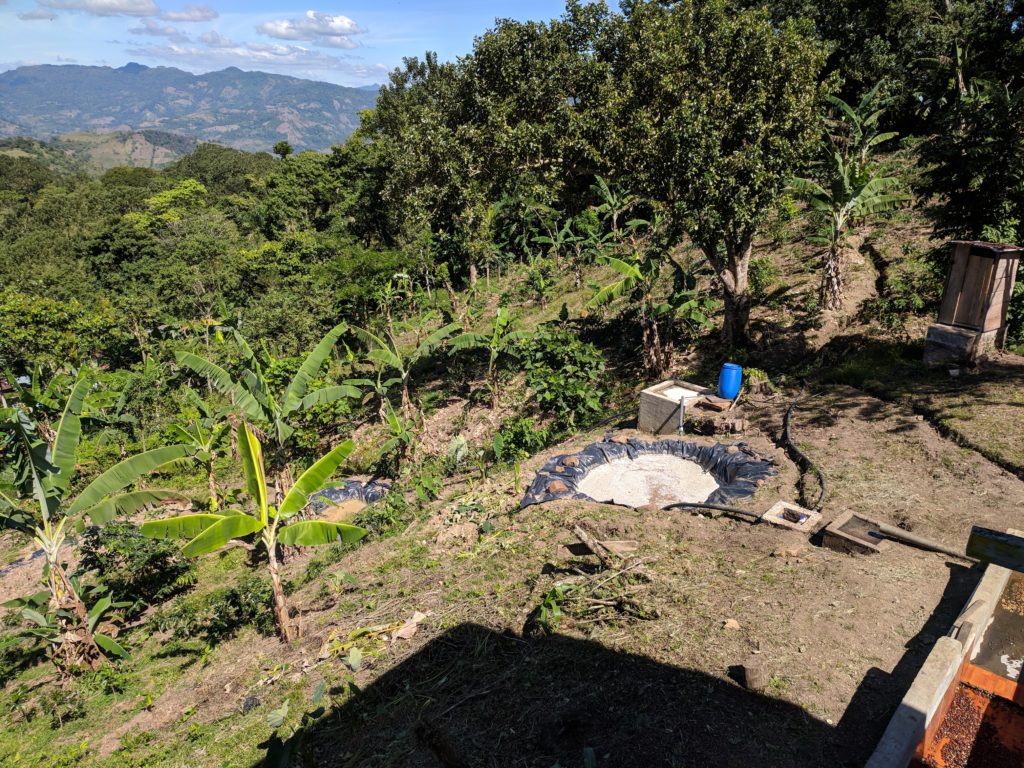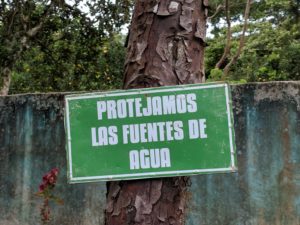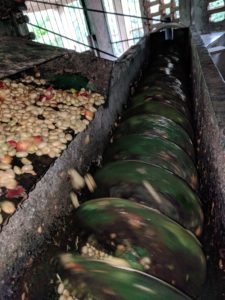The makeover. The ability to fix flaws and to transform, changing into a better version, the 2.0. It is a sexy premise – one that feeds tons of industries, catering to our most basic desires for improvement. What is left out of how these makeovers are presented in the media is how much work is required to make the changes. Real transformation doesn’t happen overnight, but is the result of hard work and investment over time.
In the Blue Harvest project in Nicaragua, we recently completed 6 wet mill makeovers, improving water use efficiency and waste water treatment just in time for this year’s harvest – the result of lots of hard work on the part of these farmers. Before we get into the details of what was changed, let’s look at why these wet mills needed a makeover.
WHY IS IT A “WET” MILL?
The wet mill is one of the ways in which coffee cherries are transformed into parchment coffee, which is then dried and milled into green coffee (I wrote about wet mills last year, while Paul had a great piece on honeys and naturals). While there are many ways to put together a wet mill, the main functions of the wet mill are straightforward: 1. Receive the coffee cherries; 2. Depulp the cherries; 3. Ferment; 4. Wash and 5. Classify coffee by density.
These are called wet mills because these processes use water, or water is used to move the coffee from one process to another. In a traditional wet mill, water is used to sort the ripe cherries, used to help lubricate the depulping machine, used to ferry the coffee to the fermentation tank, then the coffee is washed with water and then water is used to classify the coffee by density.
Here is where Blue Harvest comes in with our WET MILL MAKEOVERS. The water use in many traditional wet mills is excessive and wasteful. The wastewater that comes from the washing process and the discarded coffee pulp are untreated. This wastewater is returned to streams and rivers and is loaded with organic matter, is extremely acidic, and has high biological oxygen demand. With the aid of Leonardo Sanchez, a Costa Rican expert in wet mill waste water treatment, we designed our ideal small wet mill and waste water treatment system.
So for the Blue Harvest wet mill makeovers, we focused on a couple of key transformative issues:
REDUCING WATER USE DURING DEPULPING AND WASHING
As I mentioned in a previous post, each wet mill is slightly different as there are a myriad of factors that determine its unique design. Farmers have to consider: The landscape in which they are constructed; The access to a water source and how much water is available; The volume of coffee processed; The topography of the land; The distance from the wet mill to a surface water source; and The operational layout. For our makeover, each wet mill required its own improvement plan based on an assessment of these factors. We started by measuring how much water is used during the traditional processes and made producers aware of this. The efficiency improvements are relatively simple. We eliminate the use of water in depulping by harvesting and processing only ripe cherries and using gravity to convey the cherries to the depulper. This change also contributes to the improvement in the quality of the coffee. If the wet mill is small, the pulped coffee can fall straight into the fermentation tank. Larger wet mills require moving the pulped coffee into the fermentation tanks. Rather than using water to convey the coffee, we encourage farmers to use a screw conveyor to move the coffee.
After fermentation, farmers often wash the coffee up to 4 times to remove the mucilage and prepare the coffee for drying. Coffee gets placed into a longer canal, and water is added to the coffee, and the mix is agitated until the water runs clear and the coffee separates by density in order for it to be classified. The worst quality coffee is the lightest and runs the farthest through the canal, while the best quality coffee stays in the first parts of the canal. Tradition has farmers leaving the water on for the duration of the classification. Blue Harvest trains farmers to be more conscientious of their use, using just enough water for the washing and classifying.
TREATING WASTE WATER
The waste water generated from this process is not minimal. Untreated, it harms animal life and is unsuitable for human consumption. Many previous “treatment” systems have consisted of a series of filtration tanks that are poorly designed and sized and do not actually treat the wastewater. The Blue Harvest waste water treatment system consists of the following:
- Separation of solids
- Separation of water
- Sediment separation
- pH balancing
- Sediment secondary tank
- Bio-garden filter / mini reactors / superficial runoff
The final twist is that we encourage farmers to treat the water from their first 2 washes, the most contaminated water. When the water starts to clear, there is no need to treat it and it can be safely returned to other water sources. The water from the first two washes is sent through a series of screens to eliminate any solids – pulp, coffee, sticks that might be in the waste water. This water is then sent into a separation tank. While in the separation tank, the pH of the waste water is balanced through the addition of agricultural lime. The solids are then sent to another holding pond, while the liquid is sent to a final filter – a bio-garden, where edible plants are growing in a mix of volcanic rocks and porous soil. The water that is not used by the plants is then allowed to run off into a surface water system.

From R to left. Washing canal empties into 2 filters, then into a first sedimentation tank. The solids go into the lower lined pit, while the water is pH balanced at square concrete tank with an agricultural lime solution from the blue barrel. The water from here goes into the last filter on the L hand side, filled with volcanic rocks and soil, where malanga and other root crops are planted. Photo by Kraig Kraft.
The best news of all is that this does not require expense investments to make these improvements. Blue Harvest has done this by investing $1500 into some of the materials for the system and the farmers have contributed about $800 of their own cash towards the infrastructure. The farmers have put in the labor needed to build the new canals and the ponds. The final waste water product meets all of the Nicaraguan national laws on waste water treatment. Today, these farmers are now able to quantify the volume of water that is used for processing their coffee and they are proud of the fact they can process coffee using less water and in an environmentally responsible way.




